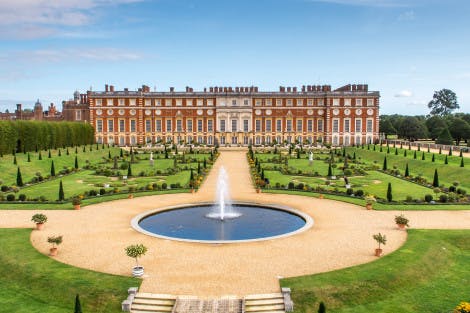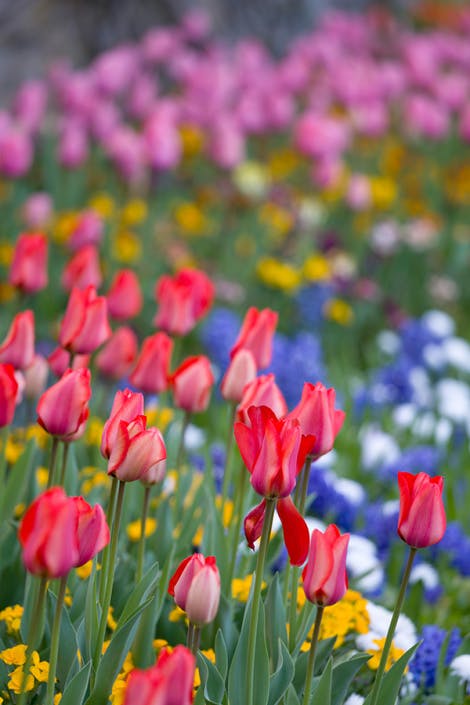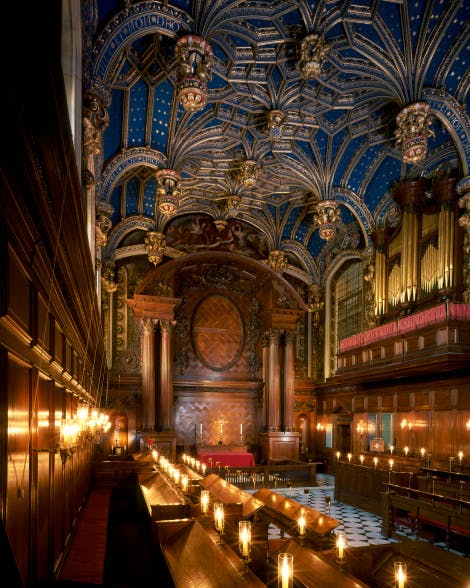
The Queen's State Apartments and private rooms
Skip the event ticket details and go to event summary.
When
Open
Ticketing information
Included in palace admission (Members go free)
Buy Hampton Court Palace ticketsThe Queen's Private Apartments are currently closed.
The Georgian Story will be closed from 28 - 30 January 2026 for urgent maintenance work.
Discover the grandeur of the Georgian royal court in the Georgian Story at Hampton Court Palace. Follow in the footsteps of queens and kings in the rooms where they lived and entertained guests.
Witness how Hampton Court was transformed into an elegant Baroque palace and became an important hub for court life and politics.
The Georgian history of Hampton Court Palace
When Queen Anne died in 1714, Georg Ludwig, Elector of Hanover, was crowned King George I of England. At Hampton Court Palace, the King commissioned a grand set of rooms for his son, Prince George, and his wife Princess Caroline, who would represent him while he was away in the summer in his native Hanover.
Although the rooms were used by George and Caroline, they were first constructed as the Queen’s Apartments for Mary II, who died in 1694 before they were fully furnished. The apartments were completed for the Prince and Princess of Wales in around 1718.

Image: The Queen's Stairs. © Historic Royal Palaces
The Queen’s Stairs
The Queen’s Stairs was designed by architect Sir Christopher Wren for William III and Mary II and leads to the Queen’s Apartments. After Caroline became Queen, the stairs were decorated by artist William Kent to complement the grandeur of the King’s Staircase in the King’s Apartments. The stairs were completed in 1734-35.
On the adjacent wall is the allegorical 'Mercury Presenting the Liberal Arts to Apollo and Diana', painted by Gerrit van Honthorst in 1628, which depicts Charles I as patron of the liberal arts. The painting also depicts Queen Henrietta Maria as Diana and royal favourite George Villiers, 1st Duke of Buckingham, as Mercury.
View the Queen's Stairs on our 360-degree image, created in partnership with Google Arts & Culture.
The Guard Chamber
This room was the gateway to the British court. It was guarded by the Yeoman of the Guard, who would have been dressed in scarlet Tudor-style uniforms. They were tasked with removing any potential threats to the royal family.
The legacy of the Yeoman of the Guard remains today – a fireplace features two sculptures of the Guard, which were probably carved by Grinling Gibbons, William III's master carver.
The Presence Chamber
This room was generally used as a place for high status guests to wait separated from lower-level courtiers. This was also the first place subjects might encounter the royal family. Crowds of people would have been eager to meet the new King, his son and his daughter-in-law.
Visitors can view two paintings from the renaissance masterpiece ‘The Triumphs of Caesar’ by Andrea Mantegna, which have been on display at the palace since 1630. During George’s reign, they were hung in the Queen’s Apartments to impress visitors.

Image: The Public Dining Room. © Historic Royal Palaces
Public Dining Room
George I spent the summers of 1717 and 1718 at Hampton Court and dined in public twice a week before his courtiers, as part of royal tradition. King George hoped to outshine his son and daughter-in-law, who held their own court. Watching George I dine was so popular that a rail and benches were introduced to manage the crowd.
Privy Chamber
When King George I visited Hanover, courtiers and ambassadors waited for an audience with the Princess and Prince in this room. The royal couple sat under the great throne canopy to hear petitions and speeches from around the world, from Venice to New York.
Drawing Room
In the Drawing Room, courtiers would meet the royal family each week. On Sunday afternoons, courtiers waited in a circle for the King or Prince and Princess to speak to them, if they held royal favour. Gambling was also a popular pastime, and both courtiers and the royal family took part.

Image: The Drawing Room. © Historic Royal Palaces
State Bedchamber
The grand bedchamber was completed in 1715 by Princess Caroline and Prince George. Here, they conducted a morning ceremony known as the levée, where they received courtiers as they dressed for the day. The State bed, made in 1715, would have been an essential part of the levée.
To keep back crowds, a rail was used: one survives on display, which was used by Charles II and George I.
You can also spot portraits of the royal family on the ceiling painted by James Thornhill. Only two years after they were completed, King George and his son had a massive argument, leading to the Prince and Princess’ exile from court.
Queen Caroline’s State bed is currently under conservation and is available to view in this room and the Queen’s Gallery.

Image: The State Bedchamber. © Historic Royal Palaces
Queen’s Gallery
The last room in the State Apartments was normally a private space, reserved for royal members to exercise, entertain guests, or talk in private. The King would have come here to discuss matters with Caroline and George. After their disastrous falling out, both parties eventually reconciled, and George and Caroline were allowed to return to court.
The Queen’s Private Apartments
Open during half term and holidays (currently closed)
In the Queen’s private apartments rooms, Caroline’s legacy can still be seen today.
In the Private Drawing Room, only the Queen’s most favoured guests could enter this space, where she hosted the era’s greatest scientists and intellectuals from all over the world.
Further into the apartments is the Queen’s Private Bedchamber where Caroline would have slept. Here, she observed a royal tradition known as ‘confinement’. This took place during the eighth month of her pregnancy, when she would have been attended by her ladies-in-waiting. Caroline had eight surviving children with her husband George.

Image: Queen’s Private Bedchamber © Historic Royal Palaces
The Queen's Private Bathroom
The Queen also had her own private bathroom and a water closet, one of the few purpose-built toilets in the palace from this time.
Caroline also enjoyed meals with her husband in her private dining room. The table is set with ornate silver dishes, as it would have been when the royal couple dined here.
In the last room was the Queen’s Oratory or a private prayer room, where Caroline could pray or hear private sermons and services from the chaplain.

Image: Queen Caroline's private bathroom and water closet. © Historic Royal Palaces
Conservation in the Georgian Story

Using heritage science to conserve Queen Caroline's State bed
The conservation team continue to work on Queen Caroline’s much-loved State bed, on behalf of the Royal Collection Trust. Take a look at how they conserve this priceless historic object using the latest scientific technologies.
Explore what's on

- Things to see
William III's apartments
Enjoy the beautiful State Apartments and private rooms of William III at Hampton Court Palace as part of your visit.
-
Open
- In line with palace opening hours
- Hampton Court Palace
- Included in palace admission (Members go free)

- Things to see
Hampton Court Gardens
Take time to explore and relax in these world-renowned gardens and find our free entry Garden Open Days dates.
- Open
- In line with palace opening hours
- Hampton Court Palace
- Included in palace admission (Members go free)

- Things to see
Home Park
Explore 750 acres of wilderness in Home Park - an appointed Site of Special Scientific Interest. Observe ancient trees and rarities from the natural world.
-
Daily 07:00 – 18:30 (October – March)
- Hampton Court Palace
- Free
Browse more history and stories

The gardens at Hampton Court Palace
A brief history of the famous royal gardens

The story of Hampton Court Palace
Home of Henry VIII and the Tudor dynasty

Chocolate fit for a king
Where royal chocolate makers prepared this expensive delicacy
